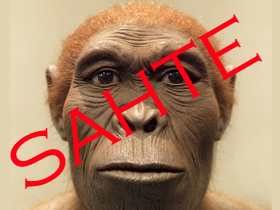 The fact that Australopithecus is nearly identical to chimpanzees in terms of their skull and skeletal structures, plus the emergence of concrete evidence that demolished the claim that these creatures walked upright, left evolutionist paleoanthropologists in a rather difficult position. Because Australopithecus is followed by Homo erectus in the imaginary course of evolution.
The fact that Australopithecus is nearly identical to chimpanzees in terms of their skull and skeletal structures, plus the emergence of concrete evidence that demolished the claim that these creatures walked upright, left evolutionist paleoanthropologists in a rather difficult position. Because Australopithecus is followed by Homo erectus in the imaginary course of evolution.
|
|
As can be seen from the use of the term Homo in its Latin name, Homo habilis is a human group and has a completely upright skeleton. Its skull volume is up to double that of Australopithecus. According to the imaginary family tree, H. erectus with a skeleton identical to that of modern man, coming immediately after Australopithecus, a species of ape similar to chimpanzees, cannot be explained in terms of the theory of evolution. Therefore, links or transitional forms are necessary. It is this difficulty that gave rise to the concept of Homo habilis.
In the 1960s, the Leakeys, the fossil hunter family, proposed the classification Homo habilis. According to the Leakeys, this new species classified as H. habilis possessed the ability to walk upright, had a relatively large brain, and was able to use tools made of stone and wood. It may therefore have been an ancestor of modern man.
New fossils belonging to the same species discovered after the mid-1980s totally altered that view. Researchers such as Bernard Wood and Loring Brace said that the term Australopithecus habilis or “tool-using South African ape” should be employed instead of Homo habilis, which means “tool-using human,” because H. habilis shared a great many characteristics with the apes known as Australopithecus.
Just like Australopithecus, it had a long-armed, short-legged and ape-like skeletal structure. Its fingers and toes were suited to climbing. Its jaw structure completely resembles that of modern apes. Its 500-cubic-centimeter brain size was the best indication that it was in fact an ape. In short, H. habilis, portrayed as a separate species by some evolutionists, was actually an ape just like all other Australopithecus.
|
|
Restricting analysis of fossils to specimens satisfying these criteria, patterns of dental development of gracile australopithecines and Homo habilis remain classified with African apes. Those of Homo erectus and Neanderthals are classified with humans.203
That same year, three experts in anatomy—Fred Spoor, Bernard Wood, and Frans Zooneveld—arrived at the same conclusion using another method. This was based on a comparative analysis of the semi-spherical canals that serve to establish balance in the inner ears of human beings and monkeys. The inner ear canals of all the Australopithecus and H. habilis specimens that Spoor, Wood, and Zonneveld examined by were identical to those of modern apes. That of H. erectus, on the other hand, was the same as that of modern human beings.204
203 Holly Smith, American Journal of Physical Anthropology, Vol. 94, 1994, pp. 307-325.
204 Fred Spoor, Bernard Wood, Frans Zonneveld, “Implication of Early Hominid Labryntine Morphology for Evolution of Human Bipedal Locomotion,”




